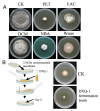Biocontrol Potential of Bacillus stercoris Strain DXQ-1 Against Rice Blast Fungus Guy11
- PMID: 40732046
- PMCID: PMC12300960
- DOI: 10.3390/microorganisms13071538
Biocontrol Potential of Bacillus stercoris Strain DXQ-1 Against Rice Blast Fungus Guy11
Abstract
Fungal diseases severely threaten global agriculture, while conventional chemical fungicides face increasing restrictions due to environmental and safety concerns. In this study, we isolated a soil-derived Bacillus stercoris strain, DXQ-1, exhibiting strong antagonistic activity against plant pathogenic fungi, notably Magnaporthe oryzae, the causal agent of rice blast. Scanning electron microscopy revealed that DXQ-1 disrupts fungal hyphae and inhibits conidial germination, with a 24 h crude broth treatment reducing germination to 83.33% and completely blocking appressoria formation. LC-MS-based metabolomic analysis identified key antifungal components, including lipids (35.83%), organic acid derivatives (22.15%), and small bioactive molecules (e.g., Leu-Pro, LPE 15:0). After optimizing fermentation conditions (LB medium, pH 7.0, 28 °C, 48 h), the broth showed >90% inhibition against M. oryzae and Nigrospora oryzae and retained high thermal (68 °C, 1 h) and UV (4 h) stability. Field trials demonstrated effective disease control and significant promotion of rice growth, increasing plant height (17.7%), fresh weight (53.3%), and dry weight (33.3%). These findings highlight DXQ-1 as a promising biocontrol agent, offering a sustainable and effective alternative for managing fungal diseases in crops.
Keywords: Bacillus; Magnaporthe oryzae; antifungal metabolites; fungal pathogen; plant disease control.
Conflict of interest statement
The authors declare no conflicts of interest.
Figures






Similar articles
-
Isolation and Identification of Burkholderia stagnalis YJ-2 from the Rhizosphere Soil of Woodsia ilvensis to Explore Its Potential as a Biocontrol Agent Against Plant Fungal Diseases.Microorganisms. 2025 May 31;13(6):1289. doi: 10.3390/microorganisms13061289. Microorganisms. 2025. PMID: 40572177 Free PMC article.
-
The Histone Deacetylases MoRpd3 and MoHst4 Regulate Growth, Conidiation, and Pathogenicity in the Rice Blast Fungus Magnaporthe oryzae.mSphere. 2021 Jun 30;6(3):101128msphere0011821. doi: 10.1128/mSphere.00118-21. Epub 2021 Jun 30. mSphere. 2021. PMID: 34190584 Free PMC article.
-
A Bacillus velezensis strain shows antimicrobial activity against soilborne and foliar fungi and oomycetes.Front Fungal Biol. 2024 Feb 23;5:1332755. doi: 10.3389/ffunb.2024.1332755. eCollection 2024. Front Fungal Biol. 2024. PMID: 38465255 Free PMC article.
-
Epigenetic modulation of fungal pathogens: a focus on Magnaporthe oryzae.Front Microbiol. 2024 Oct 28;15:1463987. doi: 10.3389/fmicb.2024.1463987. eCollection 2024. Front Microbiol. 2024. PMID: 39529673 Free PMC article. Review.
-
Biocontrol of plant pathogens by actinomycetes: a bibliometric analysis and systematic review.World J Microbiol Biotechnol. 2025 Jul 2;41(7):243. doi: 10.1007/s11274-025-04422-7. World J Microbiol Biotechnol. 2025. PMID: 40593367
References
-
- Wang S.Y., Herrera-Balandrano D.D., Wang Y.X., Shi X.C., Chen X., Jin Y., Liu F.Q., Laborda P. Biocontrol ability of the Bacillus amyloliquefaciens Group, B. amyloliquefaciens, B. velezensis, B. nakamurai, and B. siamensis, for the Management of Fungal Postharvest Diseases: A Review. J. Agric. Food Chem. 2022;70:6591–6616. doi: 10.1021/acs.jafc.2c01745. - DOI - PubMed
-
- Zheng Y., Liu T., Wang Z., Wang X., Wang H., Li Y., Zheng W., Wei S., Leng Y., Li J., et al. Whole-genome sequencing and secondary metabolite exploration of the novel Bacillus velezensis BN with broad-spectrum antagonistic activity against fungal plant pathogens. Front. Microbiol. 2024;15:1498653. doi: 10.3389/fmicb.2024.1498653. - DOI - PMC - PubMed
LinkOut - more resources
Full Text Sources
Research Materials

